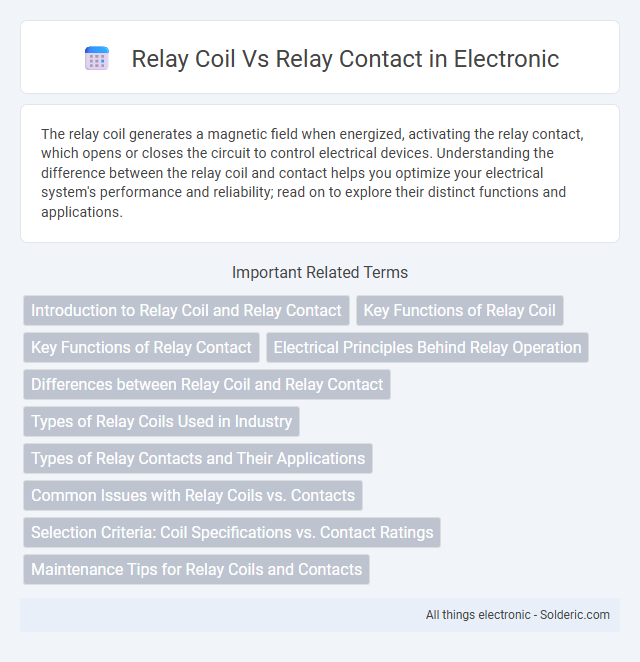The relay coil generates a magnetic field when energized, activating the relay contact, which opens or closes the circuit to control electrical devices. Understanding the difference between the relay coil and contact helps you optimize your electrical system's performance and reliability; read on to explore their distinct functions and applications.
Comparison Table
| Feature | Relay Coil | Relay Contact |
|---|---|---|
| Function | Generates magnetic field to actuate the relay | Switches electrical circuits ON or OFF |
| Role | Input component energized by control voltage | Output component that controls load current |
| Electrical Characteristics | Inductive, rated voltage and current for coil | Resistive or inductive, rated voltage, current, and type (NO/NC) |
| Voltage & Current | Low voltage, low current (control side) | Higher voltage and current capability (load side) |
| Operation | Activated by control signal to magnetize coil | Physically opens/closes contacts using magnetic force |
| Importance | Essential for relay activation | Essential for circuit switching functionality |
Introduction to Relay Coil and Relay Contact
The relay coil functions as the electromagnet that, when energized, generates a magnetic field to actuate the relay contact. The relay contact serves as the switch that opens or closes circuits, controlling the flow of current based on the coil's activation. Understanding the interaction between the relay coil and relay contact is crucial for designing reliable electrical control systems and ensuring your devices operate efficiently.
Key Functions of Relay Coil
The relay coil generates a magnetic field when energized, enabling the mechanical movement that opens or closes the relay contacts. This electromagnetic action isolates the control circuit from the load circuit, ensuring safe and efficient switching. The coil's voltage rating and current consumption are critical parameters influencing relay performance and suitability for specific applications.
Key Functions of Relay Contact
Relay contacts serve as the essential switching components that open or close electrical circuits in response to the relay coil's magnetic field activation. These contacts handle the high-current loads and ensure reliable circuit isolation, enabling precise control over electrical devices. Understanding your relay contact's key functions, such as its normally open (NO) and normally closed (NC) configurations, is crucial for optimizing circuit design and performance.
Electrical Principles Behind Relay Operation
The relay coil generates a magnetic field when energized, converting electrical energy into mechanical movement to activate the relay contact. The relay contact serves as the switching mechanism that opens or closes circuits, controlling the flow of electrical current. Your understanding of these electrical principles is critical for designing and troubleshooting relay-based control systems.
Differences between Relay Coil and Relay Contact
The relay coil is the electromagnetic component that generates a magnetic field when energized, enabling the relay to switch states, while the relay contact is the conductive part that opens or closes the electrical circuit. The coil requires a specific voltage and current to operate, and its primary function is to control the relay's switching mechanism. In contrast, the relay contact acts as the switch, handling the electrical load and directly controlling the flow of current in the external circuit.
Types of Relay Coils Used in Industry
Industrial relay coils commonly include AC coils, DC coils, and latching coils, each designed for specific voltage and frequency requirements to ensure reliable operation. AC coils often feature shading coils to prevent chatter, while DC coils provide consistent holding force in control circuits. Latching coils maintain relay contact positions without continuous power, enhancing energy efficiency in automated systems.
Types of Relay Contacts and Their Applications
Relay contacts are categorized primarily into Normally Open (NO), Normally Closed (NC), and Changeover (CO) types, each serving distinct functions in electrical circuits. NO contacts complete the circuit when the relay coil is energized, ideal for switching devices on, while NC contacts break the circuit upon energization, commonly used for safety interlocks. Changeover contacts combine both NO and NC, allowing you to select between two circuits, making them suitable for applications like motor control and signal switching.
Common Issues with Relay Coils vs. Contacts
Relay coils often face issues like burnout due to excessive voltage or prolonged activation, which can cause a failure in creating the magnetic field required for operation. Relay contacts frequently experience wear and pitting from electrical arcing during switching, leading to poor conductivity and eventual contact failure. You should regularly inspect both coils for signs of overheating and contacts for corrosion or erosion to ensure reliable relay performance.
Selection Criteria: Coil Specifications vs. Contact Ratings
Relay coil selection hinges on voltage, current, and power consumption requirements to ensure proper activation and energy efficiency. Contact ratings prioritize load voltage, switching current, and endurance to handle the connected circuit's demands without failure. Your choice must balance coil specifications for reliable operation with contact ratings for safe and effective load switching.
Maintenance Tips for Relay Coils and Contacts
Regular inspection of relay coils for signs of overheating or insulation damage helps prevent coil failure and ensures reliable operation. Cleaning relay contacts with appropriate contact cleaner removes oxidation and debris, reducing contact resistance and improving electrical conductivity. You should also check contact alignment and replace worn or pitted contacts promptly to maintain optimal relay performance and extend device lifespan.
Relay coil vs relay contact Infographic

 solderic.com
solderic.com